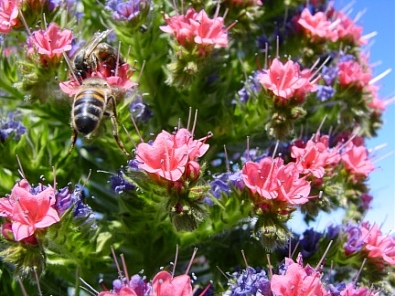Tower Of Jewels
(Echium wildpretii)
Tower Of Jewels (Echium wildpretii)
/
/

Cristobal Moreno Baena
CC BY-SA 3.0
Image By:
Cristobal Moreno Baena
Recorded By:
Copyright:
CC BY-SA 3.0
Copyright Notice:
Photo by: Cristobal Moreno Baena | License Type: CC BY-SA 3.0 | License URL: http://creativecommons.org/licenses/by-sa/3.0/ | Uploader: Gizmo II | Publisher: Wikimedia Commons | Title: Echium_wildpretii3.jpg | Notes: |

















Estimated Native Range
Summary
Echium wildpretii, commonly known as Tower of Jewels, is a biennial evergreen perennial herb endemic to the high altitude, volcanic slopes of Tenerife in the Canary Islands. During its first year, it forms a dense rosette of silver-hairy leaves, followed by a spectacular bloom in the second year with an erect inflorescence 1–3 m (3 ft 3 in – 9 ft 10 in) tall. The plant is noted for its striking cone of hundreds of small, bell-shaped red flowers that appear from late spring to early summer. After flowering, the plant typically dies. Echium wildpretii is a dramatic specimen plant, often used as a focal point in gardens due to its height and showy blooms.
The Tower of Jewels is valued for its architectural form and vibrant flower spikes that attract bees and other pollinators. It is well-suited for xeriscaping and rock gardens, thriving in full sun with low to medium water needs and well-drained soil. While it tolerates frost down to −5 °C (23 °F), it prefers a sheltered position to protect the tall flowering spikes from strong winds. Due to its size and biennial nature, it is not commonly used for border planting but rather as a statement piece. Gardeners should note that while Echium wildpretii is not typically invasive, it can self-seed under ideal conditions.CC BY-SA 4.0
The Tower of Jewels is valued for its architectural form and vibrant flower spikes that attract bees and other pollinators. It is well-suited for xeriscaping and rock gardens, thriving in full sun with low to medium water needs and well-drained soil. While it tolerates frost down to −5 °C (23 °F), it prefers a sheltered position to protect the tall flowering spikes from strong winds. Due to its size and biennial nature, it is not commonly used for border planting but rather as a statement piece. Gardeners should note that while Echium wildpretii is not typically invasive, it can self-seed under ideal conditions.CC BY-SA 4.0
Plant Description
- Plant Type: Herb
- Height: 3-6 feet
- Width: 2-3 feet
- Growth Rate: Moderate
- Flower Color: Pink, Red
- Flowering Season: Spring, Summer
- Leaf Retention: Evergreen
Growth Requirements
- Sun: Full Sun
- Water: Low, Medium
- Drainage: Medium
Common Uses
Bee Garden, Bird Garden, Border Plant, Butterfly Garden, Deer Resistant, Drought Tolerant, Hummingbird Garden, Potted Plant, Rock Garden, Salt Tolerant, Showy Flowers
Natural Habitat
Endemic to the high altitude, volcanic slopes of Tenerife in the Canary Islands
Other Names
Common Names: Red Bugloss, Tenerife Bugloss, Mount Teide Bugloss, Tower-Of-Jewels, Diamant-Natternkopf, Taginaste Roja
Scientific Names: , Echium wildpretii, Echium bourgaeanum var. trichosiphon,
GBIF Accepted Name: Echium wildpretii H.Pearson ex Hook.fil.